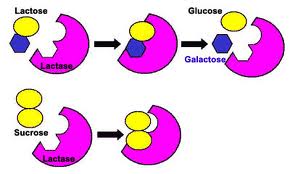Lactose Enzyme

Product description:Lactase (also known as lactase-phlorizin hydrolase, or LPH), a part of the β-galactosidase family of enzymes, is a glycoside hydrolase involved in the hydrolysis of the disaccharide lactose into constituent galactose and glucose monomers. Lactase is present predominantly along the brush border membrane of the differentiated enterocytes lining the villi of the small intestine.In humans, lactase is encoded by the LCT gene.Lactase is essential for digestive hydrolysis of lactose in milk. Deficiency of the enzyme causes lactose intolerance.The optimum temperature for lactase is about 77 °F (25 °C) for its activity and has an optimum pH of 6.
Function and mechanism:Lactase can hydrolyze a variety of substrates. While it is most notably a member of the β-galactosidase enzymatic class, lactase also has glucosidase and glycosylceramidase activity.In metabolism, the β-glycosidic bond in D-lactose is hydrolyzed to form D-galactose and D-glucose, which can be absorbed through the intestinal walls and into the bloodstream. The overall reaction that lactase catalyzes is C12H22O11 + H2O → C6H12O6 + C6H12O6 + heat. Lactase also catalyzes the conversion of phlorizin to phloretin and glucose.
The catalytic mechanism of D-lactose hydrolysis retains the substrate anomeric configuration in the products. While the details of the mechanism are uncertain, the stereochemical retention is achieved through a double displacement reaction. Studies of E. coli lactase have proposed that hydrolysis is initiated when a glutamate nucleophile on the enzyme attacks from the axial side of the galactosyl carbon in the β-glycosidic bond.[8] The removal of the D-glucose leaving group may be facilitated by Mg-dependent acid catalysis.[8] The enzyme is liberated from the α-galactosyl moiety upon equatorial nucleophilic attack by water, which produces D-galactose.
Substrate modification studies have demonstrated that the 3’-OH and 2’-OH moieties on the galactopyranose ring are essential for enzymatic recognition and hydrolysis.[6] The 3’-hydroxy group is involved in initial binding to the substrate while the 2’- group is not necessary for recognition but needed in subsequent steps. This is demonstrated by the fact that a 2-deoxy analog is an effective competitive inhibitor (Ki = 10mM).Elimination of specific hydroxyl groups on the glucopyranose moiety does not completely eliminate catalysis.
Disclaimer: the information on this website is from the internet for reference only. Please refer to the actual instructions attached to the product and the final interpretation is owned by the company.
 for: Product Quotation ( Product suppliers),COA (Certificate of Analysis), New Sales
for: Product Quotation ( Product suppliers),COA (Certificate of Analysis), New Sales
Promotion,New Products,And any other assistance.
 After send online enquiry, we will reply you as soon as possible, if not get any response on time please contact us by Tel or Email.
After send online enquiry, we will reply you as soon as possible, if not get any response on time please contact us by Tel or Email.
1. Email: info@abpri.com
2. Tel: +86 592 5365887
3. WhatsApp: +86 189 6516 2351
4. Send enquiry online:


